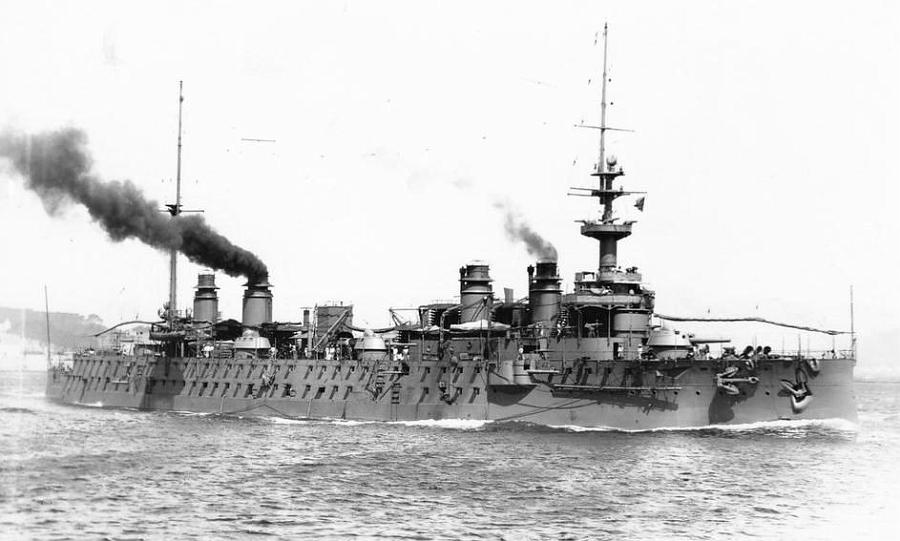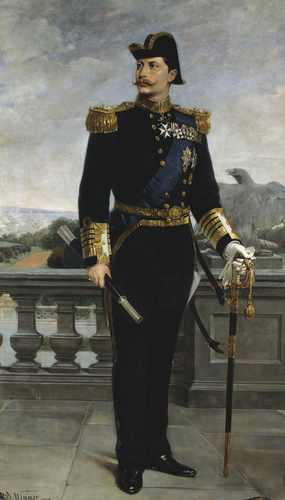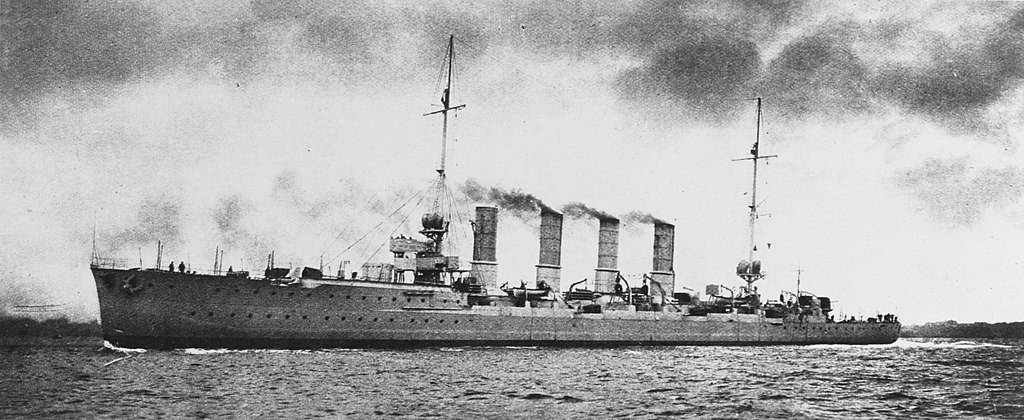| Jutland:
August 1914
By Mike Bennighof, Ph.D.
November 2021
 Britain’s declaration of war on the evening of 4 August 1914 brought war to the North Sea, but not in the way either side had anticipated. No massive fleet battle took place just outside German waters; instead, the British took up a distant blockade while the Germans remained in their anchorages, unsure even where the Grand Fleet had decamped to for its wartime base. Britain’s declaration of war on the evening of 4 August 1914 brought war to the North Sea, but not in the way either side had anticipated. No massive fleet battle took place just outside German waters; instead, the British took up a distant blockade while the Germans remained in their anchorages, unsure even where the Grand Fleet had decamped to for its wartime base.
For years, both sides had imagined how the war would unfold, and by 1914 the most fevered fantasies seemed utterly possible. A false report of German troop transports entering the North Sea from the Skagerrak, the strait between Denmark and Norway, somehow morphed into a German invasion of the sparsely-populated Shetland Islands north-east of Scotland. The fleet sortied to oppose the invaders, calling in its cruiser patrols as well. They found the islands occupied by a many sheep, but no Germans.
 Determined to stop any other insidious German plots, the Grand Fleet swept the western half of the northern North Sea in search of German armed merchant cruisers sneaking out of Germany and dispatched a squadron of elderly armored cruisers to poke among the islands of the Norwegian coast. They found no Germans (nor did the Norwegian fleet, on the lookout for violations of the kingdom’s neutrality, make contact with the cruiser squadron); the one such ship that did slip out of Germany (the armed liner Kaiser Wilhelm der Grosse) missed the Grand Fleet by only 30 miles but made it safely into the Atlantic where she destroyed three merchant ships before sinking after a battle with a British cruiser. Determined to stop any other insidious German plots, the Grand Fleet swept the western half of the northern North Sea in search of German armed merchant cruisers sneaking out of Germany and dispatched a squadron of elderly armored cruisers to poke among the islands of the Norwegian coast. They found no Germans (nor did the Norwegian fleet, on the lookout for violations of the kingdom’s neutrality, make contact with the cruiser squadron); the one such ship that did slip out of Germany (the armed liner Kaiser Wilhelm der Grosse) missed the Grand Fleet by only 30 miles but made it safely into the Atlantic where she destroyed three merchant ships before sinking after a battle with a British cruiser.
While no Germans invaded the Shetlands, they did attempt a secret mission, painting the auxiliary minelayer Königin Luise to resemble a British railway ferry and sending her alone to lay a minefield off the British port of Harwich on the war’s first night. The British cruiser Amphion and a pair of destroyers caught her at dawn and shot her up, but Amphion ran onto one of the freshly-laid mines to become the war’s first British casualty, taking most of the prisoners captured from Königin Luise with her.
British patrols in the south-western corner of the North Sea took on a great importance in the war’s first days, as the Royal Navy worked to assure the safe passage of the British Expeditionary Force’s 100,000 men plus their horses, weapons and supplies. Armored cruisers swept the waters north of the Netherlands, along with cruisers and destroyers based at Harwich. Light craft relentless patrolled the Strait of Dover. The Channel Fleet oversaw transport protection within the Channel itself, initially deploying fifteen older pre-dreadnoughts and adding a few more as they completed repairs found necessary during mobilization. Finally, the French contributed ten armored cruisers and four light cruisers to patrol the western end of the Channel.

France's Glory. The armored cruiser Gloire protected the BEF.
The British Admiralty saw two potential dangers to the troop transport effort: a German minelayer sneaking into the shipping lanes, much as Königin Luise had done, or a fast raiding light or battle cruiser steaming around the British Isles and penetrating the Channel from the west. Given the short distance across the Channel and need for rapid movement, the transports went across individually rather than in convoys, with troops moving from Southampton to Le Havre and everything else from Newhaven to Boulogne.
The transport operation began on 12 August, and completed on the 18th. Ships sailed individually, or sometimes in pairs, with the Royal Navy covering the routes rather than forming convoys. The operation moved swiftly and efficiently – the Admiralty had planned for the move for years, identifying the ships that would be requisitioned and in some cases tracking their movements on a daily basis. The BEF made it across the Channel without a single loss.
British success stung the German Navy’s leadership deeply, giving rise to fears that the generals and Socialists would once again questioned the massive resources poured into the battle fleet. The Army leadership did not see the BEF’s arrival as a major factor, but the Navy still felt the need to defend its honor. Reinhard Scheer, then commander of the Second Battle Squadron, argued that fulfilling this “impossible demand” would only disrupt the transport traffic for a day at most while forcing the battle fleet into narrow waters without its destroyers, which lacked the range to operate at far from home. The dreadnoughts would then be terribly vulnerable to enemy torpedoes and mines.
 While Scheer made a solid argument about the full battle fleet’s deployment in the Channel, he disingenuously overlooked the fact that the entire fleet would not be required. A single battle cruiser could wreak havoc there, and none of the old battleships providing security could possibly catch up. The battle cruiser would then be trapped if the Grand Fleet came south in response, but could always escape into the Atlantic. However, use of even a single capital ship would have required the express permission of Kaiser Wilhelm (over there on the right, in his British admiral’s uniform), who had forbidden the use of any ships other than torpedo boats, minelayers and submarines. While Scheer made a solid argument about the full battle fleet’s deployment in the Channel, he disingenuously overlooked the fact that the entire fleet would not be required. A single battle cruiser could wreak havoc there, and none of the old battleships providing security could possibly catch up. The battle cruiser would then be trapped if the Grand Fleet came south in response, but could always escape into the Atlantic. However, use of even a single capital ship would have required the express permission of Kaiser Wilhelm (over there on the right, in his British admiral’s uniform), who had forbidden the use of any ships other than torpedo boats, minelayers and submarines.
The German failure to attack the BEF transports, and their failure to conduct any operations beyond the minelaying on the war’s first night, convinced the Admiralty that their enemy planned something major: perhaps a “descent” on the English coast with a small number of troops, or even an outright invasion. They ordered Sir John Jellicoe, the Grand Fleet’s commander, to bring his force south on a “sweep” across the North Sea. After coaling and maintenance, the fleet left Scapa Flow at the northern tip of Scotland on 13 August.
The sweep proceeded southward to the northern edge of the Helgoland Bight, the bay fronting Germany’s North Sea ports. The destroyer flotillas operating out of Harwich came out as well, sweeping across the southern segment of the North Sea. No Germans were detected beyond what turned out to be a false report of a u-boat, and the Grand Fleet turned back for its home base one the morning of the 16th.
The High Seas Fleet’s commander, Friedrich von Ingenohl, had already considered how he wished to respond to such a British provocation: by launching a massed attack with all of the High Seas Fleet’s torpedo boats. That could be done without asking the Kaiser’s permission to sortie and wasting valuable time. It also would likely have cost the Germans most of their torpedo craft, as the Grand Fleet only went to sea behind a thick screen of its own light cruisers and destroyers.
Ingenohl had prepared for such an eventuality by stationing a line of u-boats across the North Sea to provide early warning of any British activity. None of the boats spotted the British, and this opportunity for a fleet battle in the war’s first month slipped away.
The German naval command realized that the British had placed their blockade well to the north, and even as the Grand Fleet steamed away they hatched a plan to provoke the British into doing exactly what they had just done, unknown to the Germans. Having failed to interfere with the BEF, the High Seas Fleet would dispatch light cruisers against the British cruiser-destroyer patrols.
On 17 August, two light cruisers set out to sneak past the British patrols during the night and then turn back against the destroyers at dawn, hoping to drive them eastward where they would be destroyed by superior German forces. The Germans found the British further east than they had imagined, and the operation failed to sink any of the British boats. Undeterred, German naval command sent out two more cruisers to attack British fishing trawlers on the Dogger Bank; throughout the war the Germans suspected the fishermen of transmitting position reports to the Royal Navy. They sank eight trawlers and took their crews captive, but none of the fishing boats proved to have radios aboard.

Light cruiser Rostock harassed British fishermen.
Now growing more confident that the British had abandoned the lower North Sea, thanks to their blissful ignorance of Jellicoe’s recent sweep, the German naval command planned an even more aggressive mission. The minelayers Albatross and Nautilus, each escorted by a light cruiser and six torpedo boats, would lay minefields off the Tyne and Humber estuaries, respectively. The Germans believed, incorrectly, that the British used the Tyne as a base for battleships.
The minelayers placed their deadly cargoes of the night of the 25th-26th without detection and the ships all returned safely on the night of the 26th. Several neutral merchant ships sank on the Tyne field over the coming weeks, causing diplomatic incidents. On the 27th the battle cruisers Invincible and New Zealand – operating out of the Humber, not the Tyne – narrowly missed the mines laid by Nautilus.
The two battle cruisers were on their way to participate in a British raid against the German cruisers and destroyers patrolling the Helgoland Bight, what would become the first surface action of the great War in the North Sea. That’s the subject of the next chapter.
Note: Great War at Sea: Jutland includes a scenario based on the mission of the minelayer Königin Luise, a quick-playing cat-and-mouse affair. Most of the others appear as scenarios in the Jutland: Battle Analysis.
You can order Jutland Battle Analysis right here.
Click here to order Jutland right now.
You can order Jutland: Dogger Bank right here.
Please allow an additional three weeks for delivery.
Sign up for our newsletter right here. Your info will never be sold or transferred; we'll just use it to update you on new games and new offers.
Mike Bennighof is president of Avalanche Press and holds a doctorate in history from Emory University. A Fulbright Scholar and NASA Journalist in Space finalist, he has published more books, games and articles on historical subjects than anyone should.
He lives in Birmingham, Alabama with his wife, three children, and his Iron Dog, Leopold.
Want to keep Daily Content free of third-party ads? You can send us some love (and cash) through this link right here.
|
